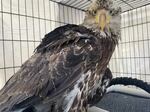A juvenile bald eagle is being treated at a Bend wildlife hospital for severe lead poisoning.

The juvenile bald eagle was found in a community member's pasture and brought to Think Wild in Bend on Sunday.
Courtesy of Think Wild
Think Wild received the bird on Sunday after a resident found it on the ground in their pasture. It had been there for a few days, unable to fly.
Upon examination, the eagle was found to have over five times what is considered poisonous levels of lead for wild raptors.
The bald eagle is being treated with chelation therapy. It’s an agent that binds to the lead molecules in the eagle’s blood, allowing it to move through and out of the bird’s body.
Think Wild says the eagle is showing positive signs, including perching, self-feeding and resistance to handling. But, it’s also lethargic with drooping wings and head.
A majority of lead-poisoned eagles don’t survive. Ammunition is the primary source of lead toxicity in birds of prey, including bald eagles.
”It is likely that the eagle recently fed on a carcass or prey animal that contained fragmented lead ammunition,” says a press release from Think Wild. “Raptor lead toxicity increases during hunting season as gut piles or unrecovered game contaminated with lead are ingested by eagles, raptors, corvids and many other species, resulting in multiple food chain toxicities. Eagle nests near farms and agricultural areas can also be susceptible to toxic lead accumulation when lead shot is used for pest control, as adults may feed poisoned rodents to their nestlings.”
People can avoid poisoning wildlife by using non-lead ammunition, fishing sinkers and rodent control.